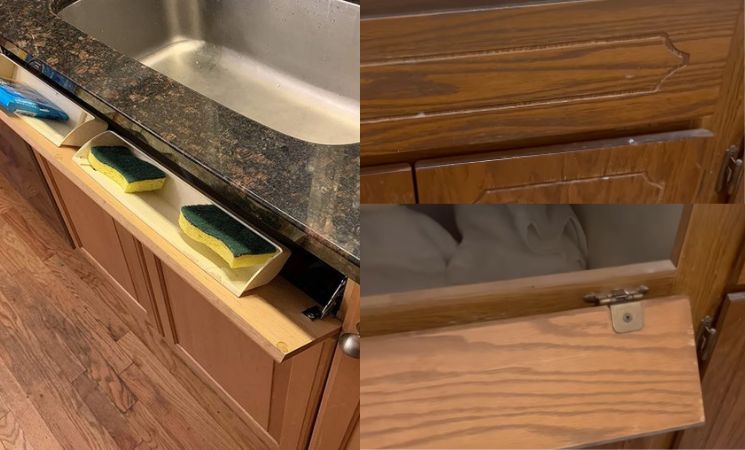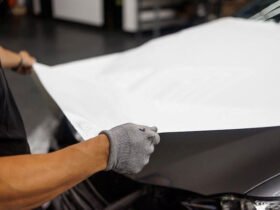As you step into a sleek, modern kitchen, the sight of flawless countertops and perfectly aligned drawers catches your eye. But upon closer inspection, you notice something curious—drawers that appear to be divided into neat little sections, yet open up as one large space. These are fake split drawers, and while they might seem like an unnecessary trick, their presence in kitchen design is a testament to the balance between form and function in today’s homes.
You’ve likely seen them in nearly every kitchen—the sleek drawer front that, when tugged, doesn’t budge. False drawers, or fake split drawers, have puzzled homeowners for years. Why create the illusion of storage where there is none? The answer, surprisingly, lies in a combination of practicality, design aesthetics, and space management. These drawers, while seemingly deceptive, serve real purposes and can even be transformed to add more functionality to your kitchen.
Different Types of Modern Drawer Designs
Today’s kitchens boast a wide array of innovative drawer designs, each serving a specific function. From soft-close mechanisms to deep pan drawers and hidden pull-outs, modern kitchens are all about efficiency.
Check out these hidden and Medium Maximera Drawers into a single High Drawer Front. This will give you an idea how modern Kitchens are innovative. Check Below
However, false drawers remain one of the simplest yet most effective ways to achieve visual balance. They complement other contemporary drawer types like handleless drawers, which open with a mere push, or corner pull-outs that maximize storage in tight spaces.
Interestingly, while fake drawers may not offer immediate functionality, their strategic placement prevents gaps in the cabinetry’s design.
This design method has contributed to the rise of minimalist kitchens, where the focus is on maintaining a clean, streamlined look. In fact, according to an NKBA study, 62% of new kitchen designs now incorporate minimalist elements, making the fake drawer an unsung hero of this trend.
Benefits of Fake Split Drawers: Aesthetic and Space-Saving Genius
False drawers often appear in kitchens for aesthetic reasons. Consider the under-sink area: plumbing, pipes, and garbage disposals make this space difficult for traditional drawers. However, leaving the space blank could disrupt the seamless flow of the cabinetry design. That’s where fake split drawers come in—they offer a uniform look that visually balances out the cabinetry, tricking the eye into believing every inch of the kitchen is perfectly in order.
At first glance, one might wonder: Why bother with the illusion? Wouldn’t it be easier to have a simple drawer face? But the truth is, kitchens today are as much about how they feel as how they function. Fake split drawers break up the monotony of large, flat drawer fronts, adding a sense of detail without disrupting the clean lines that modern design often demands. It’s the art of visual deception at play—an architectural wink that suggests there’s more than meets the eye.
Beyond visual appeal, these drawers provide practical benefits. Designers often use them to maintain consistency in drawer alignment, creating the illusion of symmetry in areas where full drawers wouldn’t be feasible. Even in cases where the drawers themselves don’t serve a functional purpose, their placement allows the entire kitchen to feel cohesive and well-thought-out.
Turning a Fake Drawer Into a Real One: Hidden Potential
But what if you could turn this design illusion into something more practical? Many homeowners have taken up the challenge of converting fake drawers into real ones. For example, a fake drawer under the sink can be transformed into a shallow tray that stores sponges, dish soap, or scrub brushes, making use of the narrow space typically reserved for plumbing.
This approach has become so popular that fake drawer conversion kits are now available on the market. These kits offer simple mechanisms and hardware to turn an unusable space into a clever storage solution. A pull-out sponge tray or tip-out compartment offers easy access to cleaning supplies without sacrificing the overall aesthetic of the kitchen.
Several companies now offer conversion kits that can make any fake drawer functional. For a cost as low as $25, homeowners can install a hinge system behind the false drawer face, allowing it to fold out and reveal a hidden compartment.
Replacing and Attaching Fake Drawer Fronts: A DIY Approach
Sometimes, homeowners may choose to replace false drawer fronts altogether or make adjustments to fit their personal design choices. Attaching fake drawer fronts requires precision to ensure that the visual illusion remains intact while blending seamlessly with the rest of the cabinetry. By using proper hardware and taking careful measurements, it’s possible to upgrade the kitchen’s appearance without the need for extensive remodeling.
For a polished look, it’s important to make sure that the edges of the drawer align perfectly with surrounding cabinets. Small details like this can make all the difference in maintaining the sophisticated appeal of a well-designed kitchen.
The next time you see a false drawer in your kitchen, you might just look at it with a bit more appreciation—and perhaps a little inspiration for what it could become.
Statistics: The Modern Kitchen in Numbers
Kitchens today are designed with efficiency and beauty in mind. According to NKBA’s 2023 findings:
- 84% of homeowners consider cabinetry the most important aspect of a kitchen’s aesthetic.
- 67% of kitchen remodels in the past year incorporated hidden or concealed storage solutions, including false drawer fronts.
- 52% of homeowners report that they value aesthetic continuity in cabinetry, favoring designs that create symmetry and balance.













